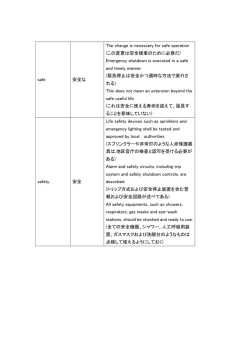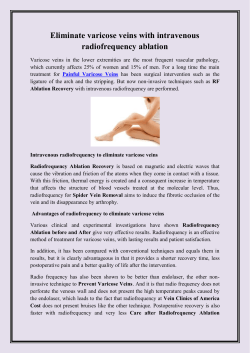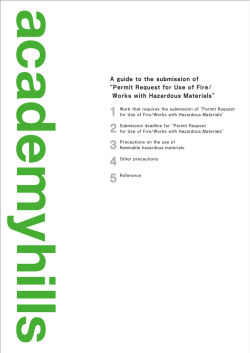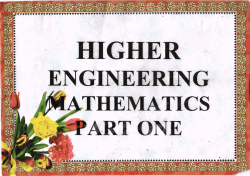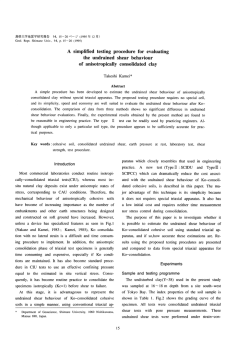
0n the Evaーuati。n 。f the ーnternaー Fricti。n 。f Anis。tr。pic, Visc。e
;
f l
(Bull. Fac. Agr. Shimane Univ.) 21 : 46 50 1987
On the Evaluation of the Internal Friction
of Anisotropic, Viscoelastic Bars
in Warping Torsion Theory.
Tetsuya NAKAO*
7 '
,
{
Q)
p
1ef
t)
:"--i,- "*FBiC
) ;O Z fli iC
FFI
e
L
f t
The warping torsion theory considering not only shear force but bending moment
in torsion was expanded to be able to describe the vibration of anisotropic, viscoelastic body. The viscoelastic, warping torsion theory is useful to predict the
internal friction values of torsionally vibrating beams at higher modes. However,
the analytically estimated values are inconsistent at the bar ends and nodal points
of the bars.
1 . Introduction
It is well-known that the torsion of a bar is described by St. Venant theory in case
1)
that the cross section of the bar is small compared with the length. In our previous
reports, the torsional vibration of wooden bars was analyzed under a both ends free
condition. According to the results, warping torsion theory consideringnot only
shear force in the St. Venant theory but bending moment in torsion must be applied
to the analysis of the vibration of the bars at higher- modes
In this paper, the warping torsion theory was expanded to be able to describe the
vibration of anisotropic, viscoelastic body such as wood by the manner developed in
2-4)
recent years.
2 . Vibration analysis of a bar by viscoelastic warping torsion theory
2)
When we consider the two different coefficients of viscous damping nE and nG
associated with Young's modulus E and shear modulus G55, the following vibration
1)
equation can be derived from the warping torsion theory :
Elw664ze
G55K62e +
Elw6-6zie6 t _VGK 68e
62e -O
Oz 6 +pJ
t 6t
(1)
where O, twrst angle ; z, Iongitudinal distance from the center of a bar ; t, time ; Iw,
warping torsion constant ; K, St. Venant's torsion factor ; p, density ; J, moment of
inertia. For the recutangular cross section of 2b x 2h,
J= 4/3 ・ bh (b2 + h2)
* Laboratory ot Wood Science and Engineering
- 46
NAKAO : Internal Friction of Anisotropic Bars in Warping Torsion Theory. 47
K=16/3 bh3{1-192/ 5.h/b VG55/G44'
1/n5tanh(n7rb/2h VG44/G55) }
n=1,3.5
and the warping torsion constant lw is expressed as follows
lw= (4bh-) 3lm
where m is the emprrical constant.
Now we use the following solution :
e =X(z) ' Y(t)
where X(z) is the normal function for a vibrating elastic bar and is expressed for
antisymmetric modes as follows
X (z) = Acosh//1z+ Ccosl/2z
//12, //22=
/s4+T4 d: 2
2 2 = GK/ (EITV) , T4= pJ/ (Elw) ' co*2, (2)
and (()
is resonant angular frequency (=27rf , f
being the resonant frequency) .
Substituting eq. (2) into eq. (1), we obtam
2 (l/ E nGK
co 2 YpJ +{A/ Elw
1 12 E Elw) cosh
IAIZ
+ dt2 = O
VE Elw)
naKcos /L2zr'X(z)'
1 1 dYdt d2Y
+ C/t22(/L22 E
d Y d2 Y
or codt22 Y+2e + dt = O ' (3)
By the definition of viscoelasticity, the internal frictions associated with E and G can
be expressed as follows
G=o nG/G
5)
tan E=co nE/E, tan
Analogous to the linear vibration systein with one degree of freedom, the equation
to evaluate the internal friction of the bar is derived from eq. (3) :
tan = 2e/(v ,
= {(Al/14 cosh /liz+ C/x24 cos /L2z) tan o*E
- 2p2 (A/L12 cosh / 1z- Cl/2g cos
2z) tan
G}/ (T4X (z)) (4)
Also for symmetric modes, by using the following equation
X (z) = A sinh //1z+ C sin IA2z
the equation corresponding to eq. (4) is derived, that is,
tan = 2ela)
= {(A/L14 sinh ICLlz+ Cl/24 sin //2z) tan
E
- 2 2 (A/L12 sinh /hlz- C/L22 sin //2z) tan o G}/ (T4X (z)) (5)
The free-free edge condition is
Elwd3eldz3 - G55Kde/dz = O
and d2e/dz2=0 at z= :!:e/2. (6)
The following frequency equation can be obtained from the condition
antisymmetric mode (odd number mode)
- //2// 1 ' tanh (/CLl /2) = (/L22 + 2 2) / (l/12
2p2) . tan (/A2g/2)
symmetric mode (even number mode)
2//L1 ' tanh (//lb/2) = (lA22 - 2p2) / (l/12 + 2 2) . tan (//2e/2) (7)
Furthermore, the following relations between coefficients A and C in eqs. (4) and (5)
can be obtained :
antisymmetnc mode :
A/C= {/h22 cos (//2b/2)}/{/L12 cosh (/L1e/2)}
symmetric mode :
A/C = {l/22 sin (/L2g/2)}/{/L12 sinh (/L1b/2)} (8)
We can obtain the values of co, //,
, and T in eqs. (4) and (5) by solving the super
equation (7) numerically. The values of internal friction of the bar are estimated
from the values and the relations in eqs.(8)
3 . Evaluation of internal friction of a bar by viscoelastic, warping torsion theory
l)
The internal friction in eqs. (4) and (5) was calculated by using the referred values
of mechanical properties of wood specimens. The values are
=29.0cm, 2b=3.92cm, 2h=0.92cm,
p=0.43, E=12.4 GPa, G55=0.823 GPa,
G55/G44=1.152, m=440,
tan E=0.008, and tan
G=0.0145,
and the resonant frequencies f from eqs. (7) and the above conditions were as
follows :
Ist mode : 1008.6 Hz,
2nd mode : 2069.5 Hz,
3rd mode : 3230.5 Hz,
4th mode : 4531.2 Hz
5th mode : 6031.1 Hz,
and
6th mode : 7700.2 Hz.
The values of internal friction are shown in Fig. I for each mode and location on
the bar. The values agree with the values of internal friction of Young's modulus E
at the bar ends and the agreement is due to the end conditions in eqs. (6). The
singular points appear at the nodal points of vibration modes besides the nodal point
at the center of the bar.
In the cases of elementary St. Venant theory, EITV=0 and tan
E=0, and isotropic
viscoelastic theory, tan E=tan G, we easily find that eqs. (4) and (5) become
tan
= tan
G.
Therefore, the results in Fig.1 are entirely peculiar to the anisotropic, viscoelastic
body.
On the otherhand, the value of internal friction can approximately be calculated
by the energy method. Namely, in eq. (7), the viscous frequency f / is calculated by
replacing the elastic constants E and G to viscoelastic constants, E x tan E and G x
tan G, respectively, and then, the internal friction can be evaluated with the two
different frequencies f
and f / as follows
NAKAO : Internal Friction of Anisotropic Barsin Warping Torsion Theory
14
T
t
'L Jf
t t
xl04
t
t
t
¥t
l
t
t
t
t
t
t
14
10
6th
c 14
-
4th
t
,u
c
o
Symmetrlc mode
2 nd
t
co 14
Antisymmetric mode
Ist mode 4 10 3rd
xl 0 3
49
10
Edge Center Edge Edge
Center
Location on a bar
5th
Fig. 1. Internal friction of an anisotropic, viscoelastic bar
at each mode and location.
Note :Arrows show nodal points.
14
Resonant frequencies and internal friction' for an anisotropic, viscoelastic bar.
t
Mode
O
Table l.
Resonant frequency (Hz)
Present
Elementary
Internal friction ( x l0-3)
Present
Approximate
Ist
1, OOO
1, 009
14. 36
14. 40
2nd
2, OOO
2, 070
13. 98
14. lO
3rd
4th
5th
6th
2, 999
3, 231
13. 45
13. 67
3, 999
4, 531
12. 86
13. 17
4, 999
6, 013
12. 27
12. 62
5, 999
7, 700
11. 72
12. lO
Table I shows the values of the internal friction by eq. (9) and the internal friction
around the center of the bar in Fig. 1. The values of the resonant frequencies
mentioned above and the frequencies by elementary St. Venant theory ignoring the
bending moment are also listed in Fig. 1. The two types of internal friction values
almost agree with each other, although the analytical values are somewhat smaller
than the approximate values and this tendency is same as that for viscoelastic
2,4,6)
Timoshenko theory. Furthermore, at higher modes, the values approach to the value
of tan
E from tan G. This corresponds to the increase of the difference between the
two types of resonant frequency values due to the occurance of bending moment
ef f ect .
Viscoelastic, warping torsion theory is useful to predict the internal friction values
2)
of torsionally vibrating bars at higher modes. However, the analytically estimated
values are mconsistent at the bar ends and nodal points for the anisotropic, vrscoelastic beams. We should give further considerations when anisotropic viscousity
are introduced into the authorized elastic vibration theory such as the above warping
torsion theory and Timoshenko theory.
50
Ref erences
1.
2,
3.
4.
NAKAO, T., OKANO,
NAKAO, T., OKANO,
NAKAO, T., OKANO,
NAKAO, T. et al. :
U.
T.
T.
J.
and AsANO, I. : Mokuzai Gakkaishi 31(6) : 435-439, 1985
and AsANO, I. : Trans. ASME, J. of Appl. Mech. 52(3) : 728-731, 1985.
and Asano, I. : Mokuzai Gakkaishi 31(10) : 793-800, 1985
of Sound and Vibration. 116(3) : 465-473, 1987
5. TIMOSHENKO, S. P. : Vibration Problem in Engineering, 4th Ed., John Wiley & Sons, New York,
1974, p. 72.
6. NAKAO, T : Doctor thesis, the University of Tokyo, 1987
7. MCLNTYRE, M. E. and WOODHOUSE, J. : ACUSTICA, 39 : 209, 1978
Appendix
The energy method to evaluate internal friction is fundamentally depends on the following
3,4,7)
relations :
tan
= D"・itan ii ii4/ Diihii4 (a. 2)
where Dii is the rigidity for elastic modulus aii ; tan ii is the internal friction associated with
aii, ; ii is the eigen value decided from the shape, vibration mode, and edge conditions of a
vibrating body and has the dimension of length-1. The most simple method to evaluate the
internal friction is to calculate independently the two types of frequencies o) and co / with the
constants Dii and Dii tan
ii, respectively. Then the internal friction is evaluated from eq. (a. 2)
3)
This method is approximately correct when the two types of independently evaluated parameters
in the numerator and denominator in eq. (a. 2) are identical. This condition is satisfied in the
case of the vibration of a bar or a beam, and also in the case of that of a plate of which
vibration mode corresponds to a beam mode. By using this method and a finite element method,
the internal friction is evaluated for the specimen with an arbitrary shape. However, this
4)
simple method is not applicable to the complicated vibration mode of a plate, that is, interaction
of two beam modes. Then the values of
substituted into the numerator
decided for the denominator in eq. (a. 2) should be
© Copyright 2026
